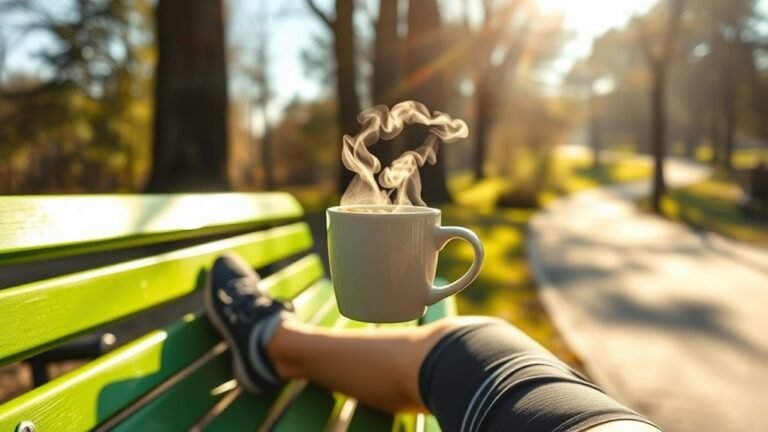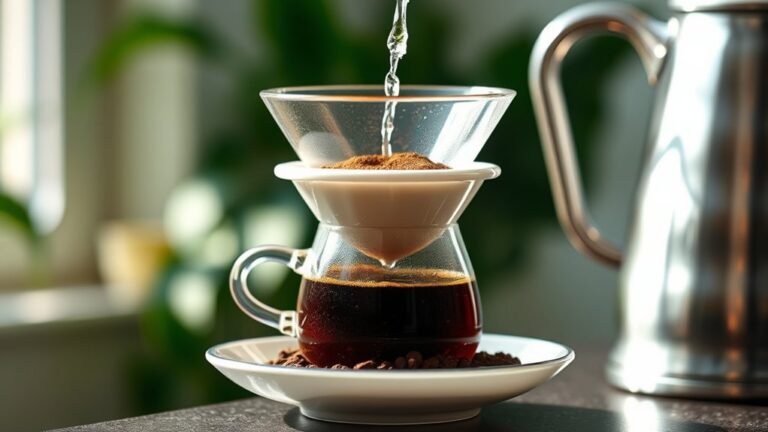Can Coffee Sit Out All Day
Coffee shouldn’t sit out all day. It deteriorates in flavor within hours due to oxidation, developing a bitter taste by the one-hour mark and losing aroma by four hours. Health concerns arise as bacterial growth can happen at room temperature, especially after a few hours. Plus, caffeine levels may alter over time. To maintain quality and safety, it’s best to consume coffee soon after brewing. There’s more insight into keeping your coffee fresh effectively.
Understanding Coffee Freshness

When you brew a pot of coffee, it’s important to understand that freshness plays a crucial role in its flavor and aroma. Coffee’s freshness is primarily affected by how it’s stored. Ideally, you should keep your beans in an airtight container, away from light, heat, and moisture. Freshness indicators include the roast date and aroma; beans lose flavor rapidly after roasting. If you notice a dull scent or stale taste, it’s likely time to rethink your coffee storage practices. Ground coffee, in particular, spoils faster than whole beans, so consider grinding just before brewing. By prioritizing proper storage and recognizing freshness indicators, you can guarantee your coffee experience remains vibrant and satisfying, ultimately enhancing your freedom to enjoy each cup.
The Effects of Temperature on Coffee
When brewing coffee, the ideal temperature typically ranges between 195°F and 205°F to extract the best flavors. However, if coffee sits out at room temperature, flavor degradation can occur within a few hours due to oxidation and the breakdown of aromatic compounds. Understanding how temperature affects your coffee can help you enjoy it at its best.
Optimal Brewing Temperature
Although many coffee enthusiasts may underestimate the importance of brewing temperature, it plays a crucial role in determining the flavor profile and overall quality of the beverage. Different brewing methods require specific ideal temperatures to extract the best flavors from the coffee grounds. For instance, pour-over techniques typically thrive around 195°F to 205°F, while cold brew benefits from lower temperatures, around 60°F to 70°F, over a longer steeping time. Using the right temperature guarantees maximum extraction of soluble compounds, enhancing sweetness and minimizing bitterness. Deviating from these ideal temperatures can lead to under-extraction or over-extraction, ultimately affecting your coffee experience. Understanding these nuances empowers you to take control over your brewing, resulting in a more satisfying cup.
Flavor Degradation Over Time
As coffee sits out, its flavor begins to degrade due to chemical reactions that occur at varying temperatures. The temperature affects both the aroma loss and the overall taste profile. Here’s a quick look at how coffee’s flavor changes over time:
| Time Passed | Temperature Range | Flavor Impact |
|---|---|---|
| 0-1 hour | 150°F – 180°F | Fresh, vibrant |
| 1-3 hours | 120°F – 150°F | Noticeable aroma loss, slight bitterness |
| 3+ hours | Below 120°F | Flat, dull taste profile, significant aroma loss |
Understanding these effects can empower you to enjoy coffee at its best. If you value flavor, consuming your coffee promptly is essential to preserving its delightful characteristics.
How Long Can Coffee Sit Out?

When coffee sits out, its flavor begins to degrade due to exposure to air and temperature fluctuations. Generally, at room temperature, coffee can maintain decent taste for about 30 minutes to 2 hours, after which it starts to develop stale notes. Understanding these factors can help you decide when your coffee is still enjoyable and when it’s time to discard it.
Temperature Impact on Coffee
While coffee may seem like a resilient beverage, its quality diminishes greatly when left out at room temperature for extended periods. When you brew coffee, the ideal storage conditions matter greatly. If you let your coffee sit out, the temperature accelerates oxidation, leading to stale flavors and aromas. Typically, brewed coffee can maintain decent quality for about 30 minutes to an hour at room temperature. Beyond that, you’re risking a rapid decline in taste, even if you used the best brewing techniques. For best flavor, consider storing your coffee in a thermal carafe or refrigerating it if you can’t finish it right away. This way, you can enjoy a fresher cup without compromising the essence of your beloved brew.
Flavor Degradation Over Time
Although many coffee drinkers might not notice immediate changes, the flavor of brewed coffee begins to degrade considerably after just 30 minutes at room temperature. This degradation manifests through aroma loss and taste deterioration, making your once-delicious cup less enjoyable.
- After 30 minutes, expect noticeable shifts in flavor.
- Within an hour, the coffee can develop a bitter, stale taste.
- By four hours, the aroma is nearly gone, rendering it unpalatable.
To maintain your coffee’s integrity, consume it promptly or opt for proper storage methods. If you value every sip, being mindful of how long your coffee sits out is essential. Your taste buds will thank you for it!
Flavor Changes Over Time
As coffee sits out over time, its flavor profile undergoes significant changes that can diminish its overall quality. One primary factor is coffee oxidation, which occurs when coffee is exposed to air. This process leads to the breakdown of aromatic compounds, resulting in a noticeable aroma loss. You might notice that what once was a rich, vibrant brew turns stale and flat within a few hours. The acidity can also shift, making your coffee taste more bitter or sour, depending on the brewing method and the coffee’s original profile. To truly enjoy your coffee, it’s best to consume it fresh, as the delightful nuances you love can quickly fade, leaving you with a less satisfying experience.
Health Considerations for Leftover Coffee

When coffee is left out for an extended period, it’s not just the flavor that deteriorates; there are also significant health considerations to keep in mind. While it might seem harmless, leftover coffee can pose several health risks:
- Bacterial growth: Room temperature can promote the growth of bacteria, which may lead to foodborne illnesses.
- Chemical changes: As coffee oxidizes, harmful compounds can form, impacting coffee safety.
- Caffeine degradation: Prolonged exposure can alter caffeine levels, affecting its intended energizing effects.
Understanding these factors is essential for your well-being. If you’ve left your coffee out all day, it’s best to err on the side of caution and avoid consuming it. Prioritizing coffee safety guarantees you can enjoy your favorite beverage without compromising your health.
Tips for Keeping Coffee Fresh
Leftover coffee can pose health risks, but with proper storage techniques, you can keep your brew fresh and flavorful. Here are some effective coffee storage and freshness tips to enhance your coffee experience:
| Storage Method | Tips |
|---|---|
| Airtight Container | Use a dark, airtight container to minimize air exposure. |
| Cool Environment | Store in a cool, dry place away from sunlight. |
| Refrigeration | If needed, refrigerate in a sealed container, but consume within 3 days. |
| Avoid Freezing | Freezing can alter flavor; only freeze if absolutely necessary. |
| Grind Fresh | Grind beans just before brewing for best flavor. |
What to Do With Stale Coffee

Although stale coffee may seem like a waste, there are several practical ways to repurpose it. Instead of tossing it out, consider these alternatives to give stale coffee new life:
Stale coffee can be repurposed in creative ways, from enriching soil to DIY scrubs, promoting sustainability and reducing waste.
- Coffee Grounds Fertilizer: Use stale coffee grounds in your garden to enrich soil and deter pests.
- Deodorizer: Place stale coffee in a bowl to absorb odors in your fridge or freezer.
- DIY Scrubs: Combine stale coffee with coconut oil or sugar for a natural exfoliating scrub.
When it comes to coffee storage, keeping it in an airtight container can minimize staleness. However, if you’re left with stale coffee, these creative uses can help you reclaim its value, promoting sustainability and reducing waste.
Frequently Asked Questions
Can I Reheat Coffee That Has Been Sitting Out?
Sure, you can reheat coffee that’s been sitting out, but keep in mind that it might lose some flavor and aroma. When you reheat, aim for a coffee temperature that’s enjoyable, ideally around 130°F to 160°F. However, if it’s been out for more than a few hours, it’s best to check for any off flavors or signs of spoilage. Your taste buds will guide you on whether it’s still worth enjoying.
Does Coffee Become Toxic After Sitting Out?
Coffee doesn’t become toxic after sitting out, but it can develop undesirable flavors and compounds over time. While it’s not dangerous to drink, there are potential health risks involved, such as bacterial growth if left in warm conditions. If you’re concerned about taste or safety, it’s best to store your coffee properly. Enjoying fresh coffee guarantees you savor its intended flavor without the worry of any negative effects on your health.
What’S the Best Way to Store Leftover Coffee?
When it comes to coffee storage, the best way to handle leftover coffee is to refrigerate it in an airtight container. This minimizes exposure to air, preventing oxidation and preserving flavor for a few days. If you want to enjoy it later, consider freezing it in ice cube trays for easy use in future drinks. Avoid leaving it out, as it can lead to a decline in taste and quality.
Can Coffee Develop Mold if Left Out?
Like a forgotten piece of bread, coffee can indeed develop mold if left out for too long. When exposed to air and moisture, mold growth becomes a real risk, especially in warmer environments. For coffee safety, it’s essential to store it properly. If you notice any unusual smell or appearance, it’s best to discard it. Remember, your health’s worth more than a cup of stale coffee!
How Does Brewing Method Affect Coffee Longevity?
Brewing techniques greatly impact coffee longevity. Methods like cold brew can enhance flavor preservation, keeping the coffee fresh longer due to lower acidity and fewer oils. In contrast, traditional brewing methods, like drip or espresso, tend to oxidize faster, leading to quicker flavor degradation. Your choice of technique matters if you want to enjoy that vibrant taste over time. So, consider experimenting with different methods to find what best suits your palate.






